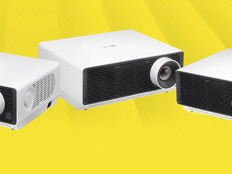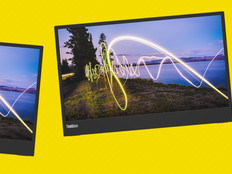Form Follows Function
HP's Z200 SFF Workstation
Many applications demand horsepower beyond that which the typical PC can provide. Unfortunately, most workstations -- the high-end units required for applications such as computer-aided design, 3D rendering and imaging, among others -- are too big to fit on or under a crowded desktop.
That's where Hewlett-Packard's Z200 Small Form Factor (SFF) workstation shines. The system boasts the processing and graphics muscle of a true workstation, yet occupies a fraction of the space, fitting comfortably in a confined area. Despite its small footprint (and relatively small price tag for such a powerful system), the Z200 SFF is big on features and benefits.
End-User Advantages
You certainly can't judge the Z200 SFF by its size. The workstation is 65 percent smaller than a typical minitower configuration, measuring 3.95 inches high, 13.3 inches wide and 15 inches deep. It sat inconspicuously below the HP ZR24w widescreen monitor I used in testing (see "True Companion"), but it could easily be stood on end as a "microtower" or placed under a desk to further reduce its footprint.
The Z200 SFF configuration I tested had a quad-core Intel Xeon X3450 2.67-gigahertz CPU, an ATI FirePro V3800 display adapter, 8 gigabytes of DDR3 1,333MHz error correction code (ECC) memory and a 500GB SATA hard drive. It didn't lack for input, output and removable storage options either, offering a DVD-R drive and a built-in removable storage reader that accommodates CompactFlash, Secure Digital (SD), miniSD, microSD and xD cards; Sony Memory Stick PRO and PRO Duo storage devices; and a USB 2.0 adapter.
Four USB 2.0 adapters on the front of the device and six more on the back add up to 11 USB adapters total -- ideal for a system that needs to accommodate a variety of digitizer pads, scanners, printers and USB-compatible engineering and lab devices. There are three internal USB ports as well, plus an optional 1394a FireWire port and an integrated Intel 82578 DM Gigabit Ethernet adapter.
The Z200 SFF can be configured with up to three SATA hard drives (at the expense of the removable storage devices) and up to 4.5 terabytes of total storage. The DVD-R drive also can be swapped for a Blu-ray Writer drive, for even larger removable storage capacity.
The system offers up to 16GB of ECC memory. This, plus its processor power, put the Z200 SFF on par with some servers, making it well-suited to such compute-heavy applications as software development and testing or image and video editing.
On the graphics front, the Z200 SFF ably handles basic 2D and 3D CAD applications. Benchmark testing revealed that the Z200 SFF delivers a price/performance ratio on par with or exceeding that of other, more expensive workstations.
What's more, the Z200 is whisper-quiet. Even under heavy operation, its fan and drive were inaudible, making the workstation a good choice for environments in which both size and sound (or lack thereof) matter.
Why It Works for IT
A number of features make the Z200 SFF particularly attractive. Aside from its size, the Z200 SFF is energy-efficient, with a 240-watt power supply rated at 89 percent efficiency. When the proper power management settings are configured, the system consumes a mere 5W of energy in sleep mode.
Maintenance and component swapping are easy as well. The Z200 SFF's case and drive enclosures can be accessed, without tools, via levers and well-marked internal releases. The power supply pivots upward for seamless access to the internal drive bay. And internal drive connections are cableless, meaning no fumbling with ribbon cables to reconnect drives following maintenance work.
The Z200 SFF also supports a range of 32-bit and 64-bit operating systems. The system came loaded with the 64-bit version of Microsoft Windows 7, but it can be "downgraded" to either 32-bit or 64-bit Windows XP Service Pack 3 or configured with 32-bit or 64-bit Windows Vista, Windows 7, Novell SUSE Linux Enterprise Desktop or Red Hat Linux Workstation 5.
Disadvantages
There are some trade-offs for a smaller form factor and lower price point.
The Z200 SFF isn't intended for medical imaging and other "heavy-lifting" graphics tasks, for example. Although it can certainly handle some of those tasks, its performance during benchmark tests was generally about 25 percent of the published results of its big brother, the HP Z800 Workstation. That's not bad, though, given that the Z200 SFF's price tag is a fraction of the Z800's.
To add more hard drives, you'll have to sacrifice one of the externally accessible removable media devices. Plus, the number of PCI-type cards you can put in the system is limited to one PCI Express Gen2 x16, one PCI Express Gen1 x16 (x4), one PCI Express Gen1 and one PCI. Because all of the slots are low-profile, full-height cards won't work.
True Companion
HP's ZR24w S-IPS Performance Series LCD monitor and Z200 SFF workstation work well together. The 24-inch monitor has a native resolution of 1,920x1,200, a 16-to-10 aspect ratio and a 3,000-to-1 dynamic contrast ratio. It offers VGA, DVI-D and DisplayPort video interfaces -- all of which are supported by the Z200 SFF -- and even acts as a USB hub, with two ports for a keyboard and mouse.
An adjustable eight-way stand allows the ZR24w to be raised, lowered and rotated from landscape to portrait mode. The latter ability is particularly helpful for image viewing, graphic design and other orientation-specific tasks. The monitor ships with rotation software that makes such reconfigurations possible without opening Windows' display controls.






